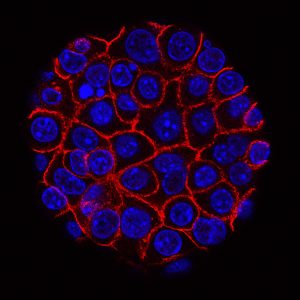
RNA breakthrough: Fluorescence used to track molecule movement
pharmafile | June 30, 2021 | News story | Research and Development | AstraZeneca, RNA, mrna
Researchers at Chalmers University of Technology in Sweden have announced a breakthrough in the labelling method of messenger RNA (mRNA) molecules, in which they are able to follow in real-time their path through cells using a microscope, without affecting their properties or activity.
The method involves replacing one of the building blocks of RNA with a fluorescent variant, which, apart from that feature, maintains the natural properties of the original base. Researchers have shown that the fluorescent unit can then be used to produce mRNA, without affecting the mRNA’s ability to be translated into a protein at natural speed.
The fluorescence furthermore allows the researchers to follow functional mRNA molecules in real time, seeing how they are taken up into cells with the help of a microscope.
Marcus Wilhelmsson, Professor at the Department of Chemistry and Chemical Engineering at Chalmers University of Technology, said: “Since our method can help solve one of the biggest problems for drug discovery and development, we see that this research can facilitate a paradigm shift from traditional drugs to RNA-based therapeutics.”
Working with mRNA molecules is challenging as they are fragile and cannot enter directly into cells, meaning they must first be packaged. The method that has proven most successful to date uses small droplets known as lipid nanoparticles to encapsulate the mRNA. There is still a great need to develop new and more efficient lipid nanoparticles, however, in order to do this the understanding of how mRNA are taken into cells must first be better understood.
Elin Esbjörner, Associate Professor at the Department for Biology and Biotechnology at Chalmers University, and the second lead author of the article, said: “The great benefit of this method is that we can now easily see where in the cell the delivered mRNA goes, and in which cells the protein is formed, without losing RNA’s natural protein-translating ability.”
The research behind the method has been done in collaboration with chemists and biologists at Chalmers and AstraZeneca, through their joint research centre, FoRmulaEx, as well as a research group at the Pasteur Institute, Paris.
The breakthrough will help accelerate and streamline the drug discovery process as it provides more accurate and detailed knowledge than current methods for studying RNA under a microscope.
Wilhelmsson added: “Until now, it has not been possible to measure the natural rate and efficiency with which RNA acts in the cell. This means that you get the wrong answers to the questions you ask when trying to develop a new drug. For example, if you want an answer to what rate a process takes place at, and your method gives you an answer that is a fifth of the correct, drug discovery becomes difficult.”
The Royal Swedish Academy of Engineering Sciences have included the project in its annual 100 list and also highlighted it as particularly important for increasing societal resilience to crises.
To ensure useful commercialisation of the method, the researchers have submitted a patent application and are planning for a spin-off company, with the support of the business incubator Chalmers Ventures and the Chalmers Innovation Office.
Kat Jenkins
Related Content

AstraZeneca shares results for Imfinzi in phase 3 trial for small cell lung cancer
AstraZeneca has announced positive high-level results from the phase 3 ADRIATIC trial, which demonstrated that …

FDA accepts BLA for AstraZeneca and Daiichi Sankyo’s datopotamab deruxtecan for breast cancer treatment
AstraZeneca and Daiichi Sankyo have announced that their Biologics License Application (BLA) for datopotamab deruxtecan …

FDA approves AstraZeneca’s Ultomiris for NMOSD treatment
AstraZeneca has announced that the US Food and Drug Administration (FDA) has approved Ultomiris (ravulizumab-cwvs) …








